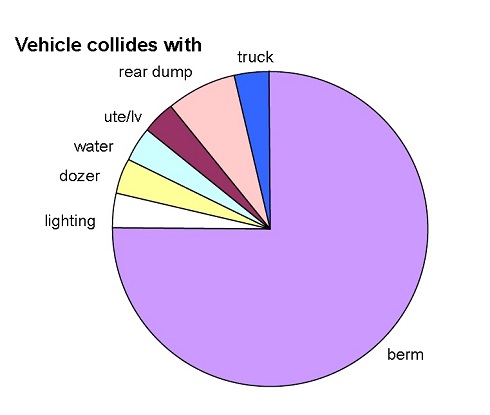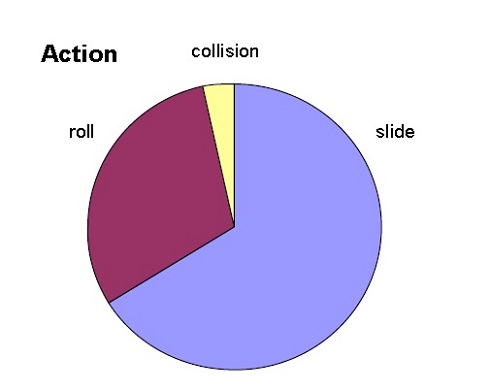
Mines safety bulletin no. 94 | 22 January 2010 | Version 1
Excessive watering of haul-roads
References and further information
MSHA haul-road inspection hand book number PH99-1-4 June 1999, US Department of Labour.
The number of incidents on haul-roads relating to over-watering is increasing. Most occur on ramps, (see location pie chart in Figure 1), and result in vehicle collisions with safety berms (bund walls).
While most water trucks have been fitted with spot sprays to alleviate over-watering, greater attention is needed to other causal factors, including steep grades, limited site distance, narrowing road ways, intersection design and/or slippery road surfaces. Figure 2 shows vehicle actions as a result of an over-watering incident and Figure 3 represents the types of vehicles involved in such incidents.
Road construction and road surface can contribute to the problem. A clay surface can lose up to 50% of its coefficient of friction through the application of water. For example, the tertiary weathered overburden clays have half the coefficient of friction of some siltstones and sandstones.
It is important that vehicle drivers adjust their speed to suit the road conditions, as coefficients of friction for road surfaces vary. The application of road surface gravel or crushed stone offers good traction values in both wet and dry conditions.
The use of road side berms may give the vehicle driver a false sense of security. Berms visually indicate the location of the roadway edge. They provide a sensation of contact to the driver if the vehicle accidentally contacts the berm, and provide restraint to give the operator a chance to regain control. The shape of the berm is critical if it is to be effective.
The design of the berms should not allow a ramp effect to assist the vehicle to topple. Mine operators need to realise that the effectiveness of the berm will depend on its width or thickness, its firmness and an effective designed height accounting for the largest vehicles in use. Figure 4 shows the proportion of collisions involving berms, emphasising the need for adequate and effective berm design.
Mine officials need to observe operations of vehicles for the over-reliance on service brakes on down grades, skidding and corner camber damage (sinking and rutting). The best perspective on the roads can be gained beside a driver in the cab. The design and maintenance of haul-roads plays an important part in surface haulage safety. Over-watering roads leads to maintenance problems and accidents due to uncontrolled movements of vehicles.
Recommendations and requirements of the mine's safety and health management system
- Mines' SOPs for dealing with excessive watering of haul-roads require urgent review (Section 129, the Coal Mining Safety and Health Regulation 2001(the Regulation)).
- Mines' risk assessments and SOPs for haul-road design, including safety berms, require urgent review (Section 128 (3) of the Regulation).
- The material types used by mines for road construction, including on the road surface to provide for frictional value, require urgent review (Section 128 (2) of the Regulation).
- Water trucks should be fitted with pulsed infusion systems that can be effectively controlled by the operator to manage the water output.
- Experienced operators should be utilised to water roads.
- Mine officials and vehicle drivers must ensure that the risk is as low as reasonably achievable.
Contact: minesafetyandhealth@dnrm.qld.gov.au
Issued by Queensland Department of Employment, Economic Development and Innovation
Find more safety notices
Search the hazards database



